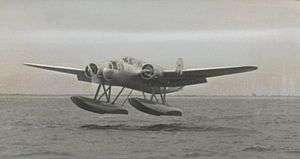Fokker T.VIII
| Fokker T.VIII | |
|---|---|
 | |
| Front view of a T.VIII in flight | |
| Role | Torpedo-bomber seaplane |
| Manufacturer | Fokker |
| First flight | 1938 |
| Primary users | Marine-Luchtvaartdienst Royal Air Force Luftwaffe |
| Number built | 36 |
The Fokker T.VIII was a Dutch twin-engined torpedo bomber and reconnaissance floatplane developed in the late 1930s, which served in the Dutch, British and German air forces. The aircraft was originally developed on request from the Dutch Naval Aviation Service for use in the home waters and in the Dutch East Indies.
Development
The T.VIII W/G was a mid-winged monoplane with a three-part fuselage of oval cross-section which consisted of a light alloy nose, a centre section of wood and a tail of steel frame with a fabric covering. The wing was constructed with two cross-beams with bakelite ribs and clad in plywood.
In the T.VIII W/M variant the tail, as well as the wings, were constructed from light alloy. The undercarriage consisted of two floats of rustproof duralumin with six waterproof compartments and an auxiliary fuel tank in each.
Operational history

The aircraft went into production after the first flight in 1938 and eleven entered Dutch service. At the time of the German invasion in 1940, nine aircraft relocated to bases in France, and on 22 May 1940 escaped to the UK to form the nucleus of No. 320 (Netherlands) Squadron RAF, Coastal Command, based at Pembroke Dock in South Wales. Eventually lack of spares meant that these aircraft were retired. Meanwhile, the Germans completed the T.VIIIs still under construction at the Fokker factory, and after evaluation at Travemünde, operated them in the Black Sea in the reconnaissance, air-sea rescue and anti-submarine role.
Early on 6 May 1941 four men – former Lieutenant Govert Steen and Corporal Evert Willem Boomsma, both of the Army Aviation Brigade, along with Fokker technician Wijbert Lindeman, and former Dutch Army Lieutenant Jan Beelaerts van Blokland – swam out to the Fokker T.VIIw TD+CL[1] moored on the Minervahaven on the IJ in Amsterdam. At dawn they managed to take off (Steen, a fighter pilot, had never flown the type before) and flew to England, evading British anti-aircraft fire, and landing at Broadstairs, Kent.[2][3] Beelaerts van Blokland and Lindeman joined the Princess Irene Brigade, with Beelaerts van Blokland becoming its commander during operations in Normandy,[4] while Steen joined No. 129 Squadron RAF, flying 79 sorties before being shot down and killed on 5 June 1942.[5]
Variants
- T.VIII W/G
- Mixed wood and metal construction. 19 built.
- T.VIII W/M
- All-metal construction. 12 built.
- T.VIII W/C
- Larger version with more powerful engines. Five had been ordered by Finland, but were captured and used by the Luftwaffe.
Operators
- Finnish Air Force ordered 5 T.VIII W/C but none were delivered.
- Luftwaffe operated several captured aircraft.
Specifications (T.VIII W/G)
Data from Encyclopedia of Military Aircraft[6]
General characteristics
- Crew: 3
- Length: 13 m (42 ft 8 in)
- Wingspan: 18 m (59 ft 1 in)
- Height: 5 m (16 ft 5 in)
- Gross weight: 5,000 kg (11,023 lb)
- Powerplant: 2 × Wright R-975-E3 Whirlwind 9-cyl. air-cooled radial piston engines, 336 kW (451 hp) each
Performance
- Maximum speed: 285 km/h (177 mph; 154 kn) at 3,000 m (9,843 ft)
- Range: 2,750 km (1,709 mi; 1,485 nmi)
- Service ceiling: 6,800 m (22,300 ft) [7]
Armament
- 2 × 7.92 (0.312 in) machine guns
- 600 kg (1,323 lb) of bombs or torpedoes
See also
Aircraft of comparable role, configuration and era
Related lists
References
| Wikimedia Commons has media related to Fokker T.VIII. |
- Notes
- ↑ "Fokker T.VIII". histaviation.com. 2003. Retrieved 18 August 2014.
- ↑ "Daring escape from Nazis in stolen plane". Thanet Gazette. 6 March 2014. Archived from the original on 2 April 2015. Retrieved 18 August 2014.
- ↑ "Steen, Govert". World War 2 Awards. 2014. Retrieved 18 August 2014.
- ↑ "Monument Jhr. J.J.G. Beelaaerts van Blokland". TracesOfWar.com (in Dutch). 2014. Retrieved 18 August 2014.
- ↑ "Apeldoorn en de oorlog: Groenoordlaan" [Apeldoorn and the war: Groenoordlaan]. apeldoornendeoorlog.nl (in Dutch). 2014. Archived from the original on 19 August 2014. Retrieved 18 August 2014.
- ↑ Jackson, Robert. The Encyclopedia of Military Aircraft. London: Paragon, 2002. ISBN 0-7525-8130-9.
- ↑ Angelucci 1983, p. 259.
- Bibliography
- Angelucci, Enzo. The Rand McNally Encyclopedia of Military Aircraft, 1914-1980. San Diego, California: The Military Press, 1983. ISBN 0-517-41021-4.
- Green, William. War Planes of the Second World War, Volume Six: Floatplanes. London: Macdonald & Co., (Publishers) Ltd., 1962.
- Van der Klaauw, Bart. The Fokker T.VIII (Aircraft in Profile number 176). Leatherhead, Surrey, UK: Profile Publications Ltd., 1967.
- Van der Klaauw, Bart. Water- en Transport Vliegtuigen Wereldoorlog II (in Dutch). Alkmaar, the Netherlands: Uitgeverij de Alk bv, year unknown. ISBN 90-6013-677-2.